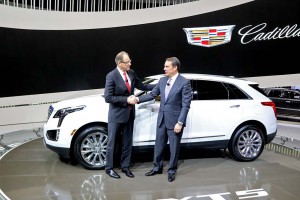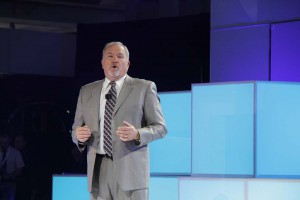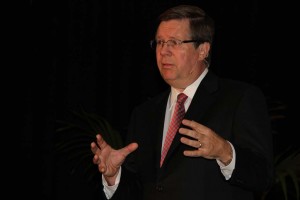Booming sales of pickups, SUVs and other light trucks may be fueling a surge in auto industry profits, but the shift is also creating at least one potentially serious problem, making it more difficult for manufacturers to meet increase tough U.S. fuel economy standards.
That is fueling industry interest in the planned “mid-term review” of upcoming Corporate Average Fuel Economy, or CAFE, standards set to reach an average 54.5 mpg by 2025. Scheduled to occur in 2017, the Environmental Protection Agency, which oversees mileage mandates, could be pressed to roll back the target to reflect shifting market demand – or a lack of the technology needed to get to 54.5 mpg.
“We’re still making great strides in fuel economy,” Joe Hinrichs, Ford President of the Americas, told TheDetroitBureau.com. But that may not be enough to offset shifting market realities, especially with the unexpected collapse of fuel prices, Hinrichs said.
“Fuel prices aren’t rising to the levels we expected when we signed up,” he said, a reference to the projections the industry made when manufacturers voluntarily went along with the Obama Administration’s call for higher CAFE. The 54.5 mpg target was actually seen as a compromise, some regulators and environmentalists originally pushing for something in the 60 mpg range.
With gasoline now averaging below $2 a gallon across the U.S., sales of utility vehicles and light trucks have exploded. Utes alone accounted for roughly 30% of the American market in 2015, and barring an explosive recovery in petroleum prices, Hinrichs predicts that could soon rise to 40%.
(Obama administration wants $4 billion for connected vehicles. For more, Click Here.)
Ford isn’t the only maker worried about meeting CAFE. Honda’s top U.S. executive, John Mendel, said that some key assumptions of the industry-government compromise aren’t coming true. Notably, while truck sales are far higher than anticipated, demand for hyper-efficient hybrids, plug-ins and battery-electric vehicles actually declined last year.
“If you try to get people to adopt higher-priced technology for the environment or to reduce our dependence upon foreign oil, that’s really painful for consumers,” said Mendel. “It’s not a rational” decision many are willing to make.
Even Toyota, which prides itself on its fleet of hybrids, fuel-cell vehicles and other high-mileage products, is worried about meeting the 2025 mandate. Facing current sales trends, “I don’t know how we can get there … on the light truck side,” Jim Lentz, Toyota’s top North American executive, told TheDetroitBureau.com.
It might be possible using the latest breakthroughs in lightweight materials and super-efficient powertrains, said Lentz, but it might also been sacrificing capabilities like towing and hauling, or raising prices substantially, and “We have to have a saleable product.”
One concern is the timing of the mid-term CAFE review. Coming in June 2017, it means most manufacturers won’t have a lot of time to respond. The average vehicle is in production for six to eight years, so that would be just one lifecycle before the 2025 number goes into effect.
(SUV sales keep growing; Ford adds for more utes to line-up. Click Here to see the story.)
“There should always be a mid-cycle review,” said Honda’s Mendel. “The problem is it’s perilous to plan your business based on a (possible) change in the standard. If it doesn’t change, you’re screwed. So, we plan to meet it.”
While EPA officials have said the 2025 fuel economy mandate is not absolutely written in stone, they’re making it clear it will be a hard sell for the industry to win a reduction in the 54.5 mpg target, especially if the argument is that carmakers aren’t selling enough battery-cars.
“These standards don’t rise and fall on sales of electric vehicles,” said Christopher Gundler, the EPA’s director of transportation and Air Quality. “Across the board every single vehicle segment is getting better. They have to because of the standards, and this is what we care about. The whole policy was designed deliberately to preserve consumer choices,” Gundler said during an appearance at this week’s Automotive News World Congress.
Gundler said the EPA is confident the industry can meet its target with gasoline technology, albeit by introducing new features to boost efficiency.
(To see more about the expected announcements from the DOT, Click Here.)
The debate is likely only to heat up over the next year and the outcome, observers caution, could be influenced by the results of next November’s presidential election.




So, should readers interpret this story as a call by some of the automakers to weaken the target efficiency standard for pickups and SUVs that the OEMs previously agreed to and that are technically possible (even without significant amounts of powertrain electrification)?…mainly to maintain profit margins? The OEMs agreed upon these 2025 “footprint based” CAFE standards and they have apparently gained even more confidence in how to meet the standards. Gas prices will probably stay low for a while, but they will not stay low forever. Does anyone think there won’t be some kind of oil supply shock in the next decade from regional instabilities? How many times do we have to (re)learn this lesson? If the mid-cycle review leads to discussions to relax the standards for each footprint, please try to inform readers how much this will really save in MSRP vs simply increase the net earnings of the OEMs. The credible analysis showed the improvements in efficiency had positive payback over the life of the vehicle.
What the auto mfgs. agreed to was what the EPA forced on them with a gun held to their head. Now that the EPA sees that consumers are not buying into the EV stupidity gimmicks perpetuated by Obama and the EPA, it’s becoming blatantly clear the auto makers have NO CHANCE in Hell of making the outrageous 54.5 mpg CAFE requirement forced on them. With the trivial number of EVs and bicycles being sold, there is no way to meet the meritless 54.5 mpg CAFE mandate – which everyone knew before we started.
ULEV2 vehicles emit very low exhaust emissions and still deliver amazingly good mpg. The pie-in-the-sky 54.5 MPG CAFE requirements from the EPA and Obama are not achievable across the entire product lines at this time or likely even by 2025. Even with a gun to their heads engineers can only do so much with the current technology that exists. New tech is being developed all the time but for now there is no known means for major auto makers who sell SUVs and pick-up trucks to meet the ridiculous 54.5 mpg mandate even with “credits” for pimping EVs and bicycles.
Now the EPA is between a rock and a hard place. Fining the auto makers thousands per vehicle which is passed on to consumers – will drastically lower new auto sales which will prevent the removal of current models from the roadways. Then the EPA will be exposed for the incompetent, political, unscrupulous criminals that they actually are.